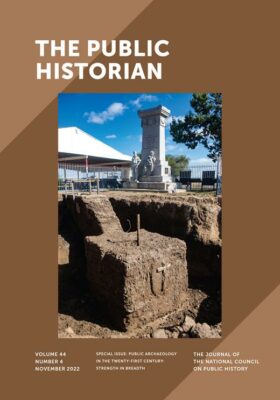Editor’s corner: Interdisciplinary Collaborations
01 December 2022 – Sarah H. Case
We are pleased to bring you our current issue, “Public Archaeology in the Twenty-first Century,” a collection of interdisciplinary, broad-ranging, and innovative articles that analyze the potential for archaeology to collaborate with public history.

The November 2022 cover of “The Public Historian” features a monument to the victims of the 1914 Ludlow Massacre and a view of an excavated cellar uncovered by the UMWA, NPS, and Colorado Coalfield War Archaeology Project. This photo appears in the article “The Power of Collaborative Public Scholarship.” Photo credit: Mike Trainer Photography
The idea for a special issue on public archaeology came from conversations between our guest editor and editorial board member, Jeremy Moss of the National Park Service, and previous TPH editor and current contributing senior editor, James F. Brooks. Their shared interest in historical archaeology and its relevance to public history shaped the vision for the current special issue.
Historical archaeology has been discussed in the pages of TPH before, including in our special issue “Conversations in Critical Cultural Heritage,” guest edited by Amy Lonetree and Jon Daehnke (volume 41, issue 1, February 2019), but this is our first sustained focus on the field. The current issue furthers the earlier issue’s discussion of shared authority, heritage and memory, and cross-disciplinarity. The articles here, many of them co-authored by scholars trained in different fields, often explicitly consider the promises and complexity of interdisciplinary work. All analyze issues of community involvement and the ethics of working with descendants and other stakeholders, and several view their work explicitly as a means to confront and comprehend, and perhaps even alleviate, historical trauma. Towards this goal, many emphasize the importance of including descendants from the inception of public archaeological projects. Taken together, these essays offer a rich overview of the state of the field of publicly engaged interdisciplinary scholarship.
Readers interested in more should look to the forthcoming volume, a kind of sister companion to the special issue, edited by James F. Brooks and also called Public Archaeology in the Twenty-first Century, published by the University of Georgia Press. Together these publications demonstrate the richness of the conversation between public historians and historical archaeologists.
~Sarah H. Case, the editor of The Public Historian, earned her MA and Ph.D. in history at the University of California, Santa Barbara, where she is a continuing lecturer in history, teaching courses in public history, women’s history, and history of the South. She is the author of Leaders of Their Race: Educating Black and White Women in the New South (Illinois, 2017) and articles on women and education, reform, and commemoration.



